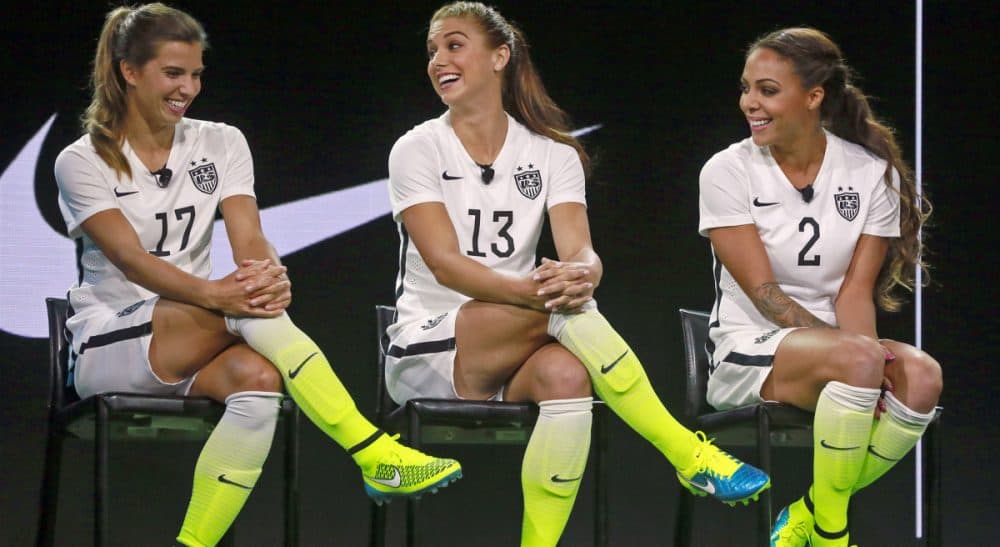Advertisement
The Women's World Cup Is Still Oppressively Sexist

This week, the U.S. women begin their quest to win the World Cup, a feat they haven’t accomplished since July 10, 1999. More than 90,000 people attended the match that day at the Rose Bowl in Pasadena, California, while 40 million watched on TV. I watched, too, from a stuffy, third-floor apartment in a Somerville triple-decker; I covered my eyes as Brandi Chastain buried her penalty kick in the goal’s top-right corner, lifting the U.S. to victory over China.
As a player, I didn’t have one thousandth of Mia Hamm’s talent, but how her team captured my imagination. Sally Jenkins, of the Washington Post, said it best in the HBO documentary, "Dare To Dream": “Everybody forgot that they were chicks ... the idea that these were athletes, as opposed to female athletes.”
Women have been fighting for lasting equality in sports ever since.
American sports fans prefer their superstars to look like superheroes (LeBron James is worthy of a Marvel comic). But the U.S. women’s national team, with their shocks of blond hair, long ponytails and blue fingernails, could be mistaken for faster and fitter versions of normal people. As my husband, a dedicated women’s soccer fan, said, “They look like girls I went to high school with.” Don’t be fooled: These women are far from normal. They are finely tuned, exquisitely trained machines.
But the women’s team just isn’t getting the attention or respect it deserves. Especially if you compare it to the promotion the U.S. men — a thoroughly mediocre team, at least by global standards — received in the run-up to the World Cup last year (see: “I believe that we will win”).
I do not begrudge the American men the spotlight, but the facts are hard to ignore: Their best-ever result in a World Cup was third, in 1930. In more recent memory — the 2010 and 2014 tournaments — they’ve barely made it to the knockout stage.
The U.S. women, meanwhile, are consistently among the best teams on the planet. They’ve won the World Cup twice (in 1991 and 1999) and made it to the semifinals in all six women’s World Cup tournaments. In between, they’ve also won four Olympic gold medals. (This year FiveThirtyEight gives the U.S. a 26 percent chance of winning the whole shebang, second only to Germany, at 32 percent.).
Everybody forgot that they were chicks ... the idea that these were athletes, as opposed to female athletes.
Sally Jenkins, Washington Post
The pay disparity between men and women, while deplorable overall, is even worse in professional soccer. Abby Wambach — the heart and soul of the American team and the all-time international leading scorer for men and women -- made about half of what the U.S. men’s captain did (bonus points if you know his name).
And don’t even get me started on FIFA, soccer’s international governing body. In addition to being a corrupt organization (as we now know all too well), it’s also one of the most sexist. In a recent piece in The Guardian, Penny M. Venetis, executive vice president and legal director of Legal Momentum, called the gender discrimination at FIFA “extreme enough to violate the law in almost every country where FIFA tournaments are played...”
The current women's team hasn’t been ignored, not exactly. They have received some media exposure: a recent New York Times profile on veteran Wambach, a Sports Illustrated cover and a new flashy spot by Nike. But by and large, the world’s biggest women-only sporting event feels like a secret -- a cute sideshow relegated to the backlogs of espnW. There’s no official Women’s World Cup app, for example, and the tournament isn’t even included in apps made by FIFA, ESPN or Fox Sports (the network broadcasting this year’s Cup). ESPN’s preview show last Friday night was delayed an hour and a half, to accommodate the end of a college baseball game (and not even a good one: the Florida Gators beat the Florida State Seminoles 13-5).
by and large, the world’s biggest women-only sporting event feels like a secret -- a cute sideshow relegated to the backlogs of espnW.
One could reasonably argue that more attention is given to the men’s World Cup than the women’s, because the men draw more viewers, and more advertising dollars. That may be true, but in the U.S., the argument isn’t airtight. The 1999 women’s final is the second most-watched match in American history (just behind the 2014 U.S. men-Portugal game), and more people watched the 2011 World Cup final between the U.S. and Japan than the Kentucky Derby. Excitement around the women’s national team has given birth to three professional leagues, including today’s Women’s Premiere Soccer League (WPSL). And the women’s team — especially that 1999 team — played a huge role in inspiring kids, and girls in particular, to play soccer. According to Youth Soccer, player registration jumped from 2.3 million in 1995 to over 3 million by 2000, and enrollment has continued to rise.
The summer of 1999 seems like a lifetime ago. But now, as the mom of 17-month-old twin girls, I have even more reason to seek out examples of tenacity and strength, especially when it feels like the most prominent expression of womanhood is posing for the cover of Vanity Fair.
Canada will play host to 24 national teams over the next month, with the final scheduled for July 5 in Vancouver. In spite of a lawsuit brought by players against FIFA and the Canadian Soccer Association, teams will play the entire tournament on turf, a rubber and plastic surface that’s hotter (20 to 30 degrees by some estimates) and tougher on players’ bodies. No matter. Wambach will spear countless balls off her forehead. Megan Rapinoe will send balls sailing the length of the pitch. Christie Rampone will chase down breakaways, because at 39 (and a mother of two), she’s still one of the fastest people on the field. Let’s celebrate these players not for being women, but for being powerful athletes. Watch them run, sweat and tackle.
